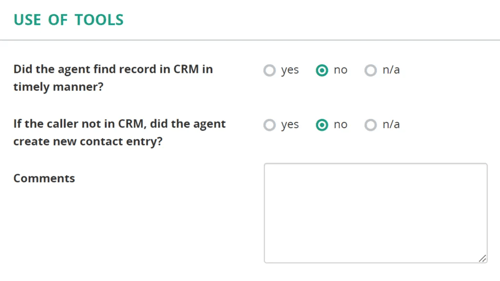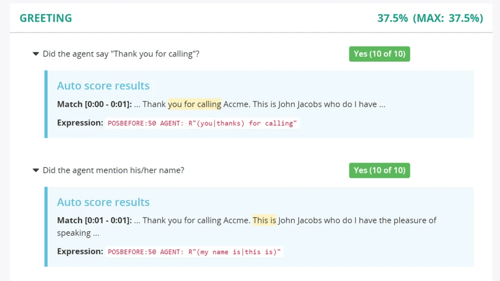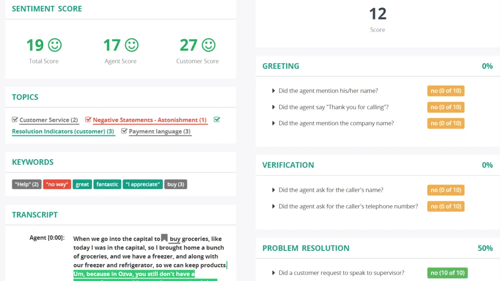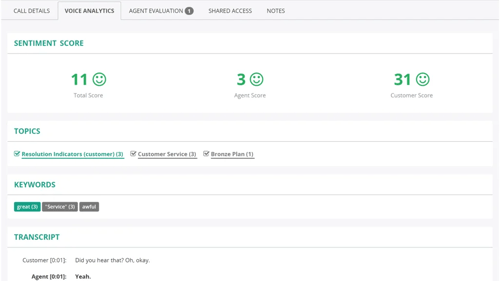Agent Evaluations Best Practices: The Importance of Automated Call Scoring
An effective agent evaluation process is key to knowing how your contact center is performing. How can your contact center use agent evaluations to get the best ROI?
In order to improve customer experiences, customer service standards, and more, contact centers need to know how their agents are performing. MiaRec has provided hundreds of Voice Analytics and Automated Quality management solutions for contact centers to improve their agent evaluation processes.
In this article, we will review how you can set the right metrics to get the best understanding of your agents’ performances. By the end of this article, you will know you can utilize these metrics and Voice Analytics to automate agent evaluations.
We will be covering the following topics:
- Best Quantitative Metrics To Assess Agent Performance
- Determining Agent Quality Scores With Automated Call Scoring
- How To Get Agents Involved
What Is An Agent Evaluation?
Agent evaluations are part of your contact center's Quality Assurance (QA) process. Positive agent evaluations result in better customer experiences, which in turn encourages customer loyalty and increased revenue.
Contact centers can evaluate agents through manual agent evaluation forms, automated call scoring, customer surveys, and more. Your criteria and metrics can vary depending on how and when agents are being evaluated.
Best Quantitative Metrics To Assess Agent Performance
There is a lot to consider when managing your agent evaluations. Your metrics could include how well an agent adheres to the script, how fast the agent handles the call, and much more.
Quantitative metrics are useful because they are easy to track. We have included popular metrics that you can use to measure your agent’s productivity and performance.
Customer Satisfaction (CSAT): The CSAT is how customers feel about your organization or services. Your CSAT can help you better align with customer expectations, improving customer satisfaction and service quality.
Net Promoter Score (NPS): One way to measure customer satisfaction is through NPS. A net promoter score asks, “On a scale of 0 to 10, how likely are you to recommend our product/service to others?" Based on the customers’ answers, customers are separated into promoters (rating 9-10), passives (rating 7-8), and detractors (rating 0-6).
The NPS is calculated by subtracting the number of detractors from the number of promoters. A high NPS indicates a higher level of customer satisfaction and loyalty.
First-Contact Resolution: The First-Contact Resolution measures how contact center agents address a customer's concern or issues during the initial interaction. The goal for all agent calls is to solve customer concerns in as little to no follow-up calls as possible.
A low FCR could suggest that customers are frustrated and not getting their questions answered because of the need for repeat calls and additional follow-up interactions. Contact centers can monitor FCR by analyzing call recordings to measure customer feedback and agent performance.
Average Call Duration: Average Call Duration is how long the customer is on call for. The global average call duration is typically 4 minutes, but this could vary depending on your industry.
Average Handle Time: Your AHT measures the average time taken by an agent to handle a customer interaction. It includes talk time, hold time, and any after-call work. A lower AHT often indicates efficient handling of customer inquiries. However, you need to be careful to set realistic expectations. If the target AHT is too low, agents may feel pressured to rush customers and compromise service.
Determining Agent Quality Scores With Automated Call Scoring
While metrics such as NPS and AHT are important, a quality management process also needs to consider whether the agent was professional and compliant. These metrics cannot be easily quantified in the way average handle times are.
Beyond Post-Call Surveys
Many contact centers grade NPS through post-call surveys, but this option is unpopular with customers (response rates have dropped to 5% in recent years). Additionally, post-call surveys are not always an accurate indicator of how the customer actually feels.
Since post-call surveys are done after the call, it does not measure how customers were feeling throughout the call. This can also result in biased reviews of agent performance. Even if an agent acted professionally, the customer could give a poor review because they were unhappy with an answer, they had a bad day, or for a variety of reasons unrelated to the agent.
Because post-call surveys are unpopular, and also not an accurate measure of agent performance, we do not recommend using post-call surveys as your primary method of gathering customer feedback on agent performance.
Get The Full Picture Of Your Agent’s Performance With Sentiment and Topics Analysis
Your contact center likely has more customers calling agents than customers filling out post-call surveys. Rather than requesting customers to fill out a survey, you can instead directly score customer calls with Sentiment and Topic Analysis to measure customer sentiment and agent performance.
An automated call scoring process in combination with Sentiment and Topics Analysis will produce better insights than a manual process. Sentiment Analysis will break down agent interactions so that you can understand how customers were feeling throughout the call. Meanwhile, Topic Analysis will organize these calls by meaningful insights and trends.
Manual vs Automated Call Scoring
While more contact centers have adopted self-service options such as virtual assistants or chatbots, most consumers still prefer live agents to help them answer their questions. In a national survey conducted by OnePoll, nearly 70% of respondents reported that live agent interactions were their preferred method of communication when interacting with a company’s customer service department.
As customers continue to willingly call contact center agents, grading agent calls can provide you with a better sample size than post-call surveys. However, contact centers with manual call scoring processes will benefit less than contact centers with automated call scoring processes.
As the name implies, manual call scoring is done by supervisors or a Quality Assurance (QA) department who have to manually listen to and assign scores to call recordings. While manual call scoring has some benefits, such as allowing the supervisor to listen directly to the call and know what was said, it also comes with a lot of drawbacks. Manual call scoring can be biased due to personal preferences or similar factors influencing the evaluator's opinion.
Because supervisors have to listen to the recordings themselves, it is not a very efficient process. It is time-consuming to manually assess every agent call in your contact center. In general, most contact centers are only able to grade less than 5% of their calls manually.
If contact centers are not able to evaluate a majority of their calls, they will not know how their agents are performing, or if they are compliant. Regardless of where your contact center is located, there will be some kind of compliance regulation or guideline you have to follow. If you cannot verify whether agents are adhering to compliance measures (for example, some agents have to state a call is being recorded), you could be leaving yourself open to potential fines and lawsuits.
Automating the call scoring process with Voice Analytic features such as Auto Quality Management features will provide you with more comprehensive and objective information. Instead of only being able to grade a fraction of your agents’ interactions, the Auto QM will score 100% of the calls for you.
How To Use Voice Analytics To Automate Call Scoring
Compared to manual call scoring, an automated call score process with Voice Analytics will give you a more in-depth view of your agent’s performance.
Contact centers typically evaluate agent calls through agent evaluation forms. These are often pre-made forms that score agent calls on your KPIs. They can grade the agent on their professionalism, compliance, and more.

Screenshot of MiaRec’s customizable Agent Evaluation form
An Auto Score Card is an AI-driven agent evaluation tool that automatically evaluates 100% of agent calls based on your agent evaluation form’s criteria. Supervisors can review agent performances without having to listen to calls. You can customize the form’s criteria as needed to measure agent compliance, performance, and more.

Screenshot of MiaRec Auto Call Scoring showing Call Scoring example questions and scores measuring call script adherence.
Your Auto Scoring tool will then calculate the final score and create an evaluation report for the call.

Screenshot of MiaRec's customizable Agent Evaluation form alongside Sentiment score and Topic categorization
These reports can utilize Sentiment and Topics Analysis to break down why a call was graded positively or negatively. It could highlight parts of a transcript to show when a customer was frustrated, or if an agent had not followed the script, and more.
Topic Analysis categorizes your calls by customizable keywords and key phrases. You can sort calls by compliance, payment language, and more. This makes it easier to review calls based on a specific topic, such as reviewing how customers feel about a specific topic, if customers are facing the same payment issues, and more.
MiaRec Sentiment Analysis uses NLP-based Sentiment Analysis to analyze calls. NLP-based Sentiment measures customer satisfaction based on keywords and phrases said by the customer and agent. These results are shown through sentiment scores, which makes it easy to understand if a call had gone positively or negatively.

Screenshot of MiaRec Sentiment scores and Topics categorization
You can use Topics and Sentiment Analysis to ensure agents are following compliance and performance policies. You could also generate personalized coaching tips to improve agent performance, monitor new hires, and more. As your Voice Analytics solution gathers insights into why customers are calling and how they are feeling, these insights can also support marketing strategies, sales campaigns, and more.
How To Get Agents Involved
Agent evaluations are not static, they are constantly changing to reflect contact center operations, agent performances, customer experiences, and more. One of the best ways you can make sure your agent evaluations are accurate and effective is to ask your agents for their feedback.
By letting agents give feedback on how they should be evaluated, you are also creating a collaborative environment where their opinions are being listened to. There should be systems in place so that it is easy for agents to critique and evaluate the agent evaluation process.
Another way agents can get involved in the agent evaluation process is by including self-evaluations. Self-evaluations are a great way for supervisors to better understand the agent’s point of view and begin conversations around training and improvement.
Conclusion
From determining metrics to implementing agent feedback, there is a lot to consider when setting and maintaining a quality agent evaluation process.
We generally recommend not to solely rely on quantitative metrics such as NPS and AHT, but to look at the overall quality of customer service your agents are providing. Adopting an automated call scoring process that utilizes Topics and Sentiment Analysis can grant your contact center the full picture of its agents’ performances.
MiaRec can help your contact center harness the power of Topics and Sentiment analysis for the best customer and agent insights. Reach out to our sales team to learn more about how Voice Analytic solutions can transform your agent evaluation process.
You May Also Like
These Related Stories

Introducing MiaRec's Auto Score Card: Evaluate Agent Performance On 100% Of Your Calls

How Contact Center AI Can Help Reduce Customer Churn

